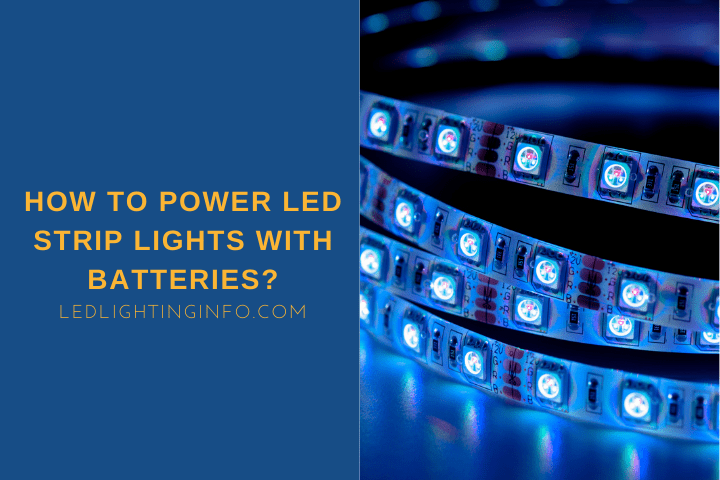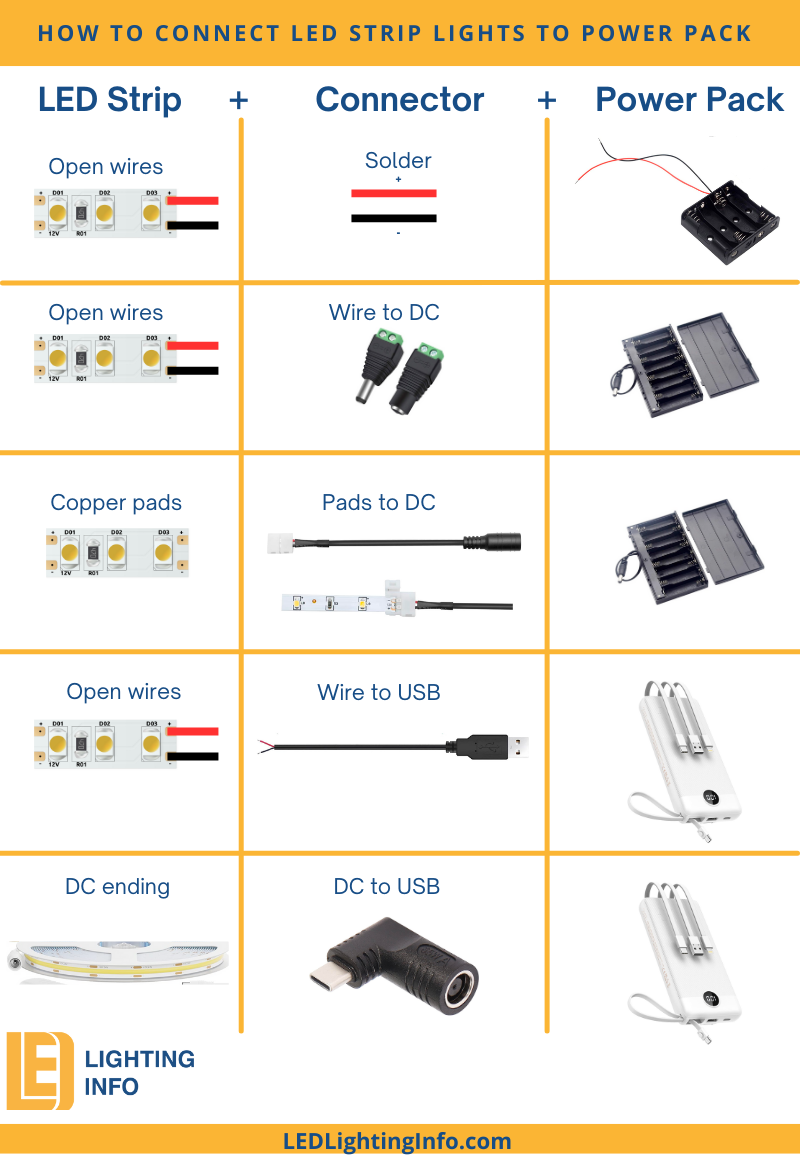LED strip lights are fast becoming one of the more popular ways to add unique lighting to your home.
They’re flexible enough to be placed almost anywhere is a real benefit.
But that flexibility is limited by one thing – a power supply.
Typically, you’d try to mask the wiring to remain hidden, but what if that was either impossible or just a lot of work? Can you power LED light strips with battery packs?
LED strip lights can be powered by a battery, but you’ll likely need to rewire them. The most important thing is matching the voltage of the strip – too many volts will damage the strip. Too few, and it won’t work. A 3-meter strip will last around 20 hours if connected to 8 AA batteries.
There are quite a few things to cover, so let’s dive into an exploration of:
- How to connect a strip to batteries
- How long battery LED strip lights will work
- What you need to consider for battery power
- Whether you can convert LED strips to battery powered
Table of Contents
How To Connect LED Strip Lights To A Battery Pack?
There are different ways to connect LED strip lights to a battery – it depends on whether you buy an LED strip that normally uses a DC power receptacle, loose wires, or exposed copper pads to connect to the power source.
Here is a simple visual diagram.
Connecting Battery Packs To LED Strip Lights Designed For DC Power
The easiest option for connecting an LED strip to a battery pack is to buy one that normally uses a DC power receptacle.
With these, you normally attach the plug to the DC wire – instead, you can buy a battery box or a power bank that offers DC out connection.
There’s no rewiring involved with these – you just plug the strip into the battery pack, and it works.
Connecting Battery Packs To LED Strip Lights With Exposed Copper Pads
If your LED strip only has exposed copper pads, you’ll just need a clip-on connector.
Use 2-pin adaptor if you want to connect to a battery pack designed for DC power, or one of these connectors if your battery source is open wire.
Make sure that the connector you buy has the same number of pins as your strip has copper pads.
Connecting Battery Packs To Loose Wires LED Strip Lights
If you want to connect a light strip with loose wires to a battery pack, just find one that also has loose wires.
You’ll need to make sure it can hold enough batteries to power your strip – more on that later.
Connect the positive wires of the battery pack and strip light together, and do the same for the neutral wire.
You can do this using a low voltage connector like this one.
Alternatively, you can also solder the connection.
How Long Can A Power Bank Power LED Strip Lights?
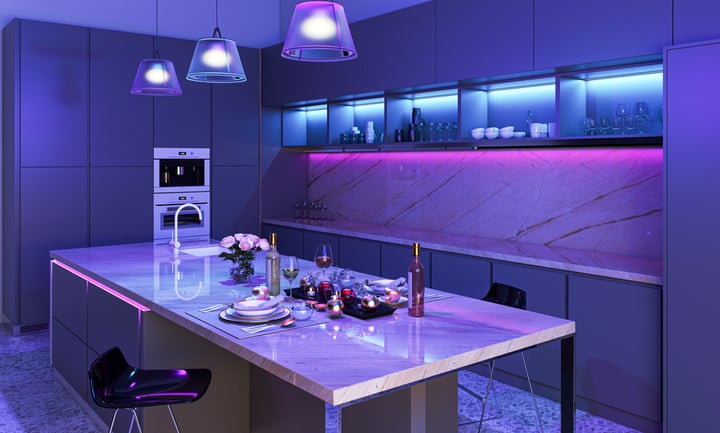
With the total wattage of the strip, you need to know how many watt-hours of power your power bank can provide. Multiply the milliamp hours by the total voltage and divide by 1,000 to give you the watt-hours. Then divide that by the total wattage of the light strip to determine how many hours it will last.
So, say you’re using a 12,000 mAh power bank rated at 12V:
- 12,000 x 12 = 144,000
- 144,000 / 1,000 = 144 watt-hours.
Unfortunately, battery life is always presented as mAh, so you’ll need to do some converting first.
So, if you have a short 12W LED strip, then that 12,000 mAh power bank would power it for 12 hours (144 watt-hours divided by 12 watts = 12 hours)
Here are a few more examples to illustrate:
| Strip length | Total wattage | Battery mAh | Watt-hours at 12V | Time On Charge |
|---|---|---|---|---|
| Kasa 16.4ft strip | 12W | 8 x high-capacity AA batteries – total 19,200 mAh | 230.4 | 19.2 hours |
| Kasa 16.4ft strip | 12W | 24,000 mAh power bank | 288 | 24 hours |
| Hue 6ft 8” strip | 20W | 8 x high-capacity AA batteries – total 19,200 mAh | 230.4 | 11.5 hours |
| Hue 6ft 8” strip | 20W | 24,000 mAh power bank | 288 | 14.4 hours |
| Chained 3 x Kasa 16.4ft strip | 36W | 8 x high-capacity AA batteries – total 19,200 mAh | 230.4 | 6.4 hours |
| Chained 3 x Kasa 16.4ft strip | 36W | 24,000 mAh power bank | 288 | 8 hours |
As you can tell, that’s not a huge amount of constant time before you have to disconnect the battery and recharge it, especially if you’re powering multiple strip lights connected together.
But if you can get a high-capacity power bank, and you’re powering a shorter strip, plus you aren’t constantly leaving them on, then it may be worth it.
What Are Battery Requirements To Power LED Strips?
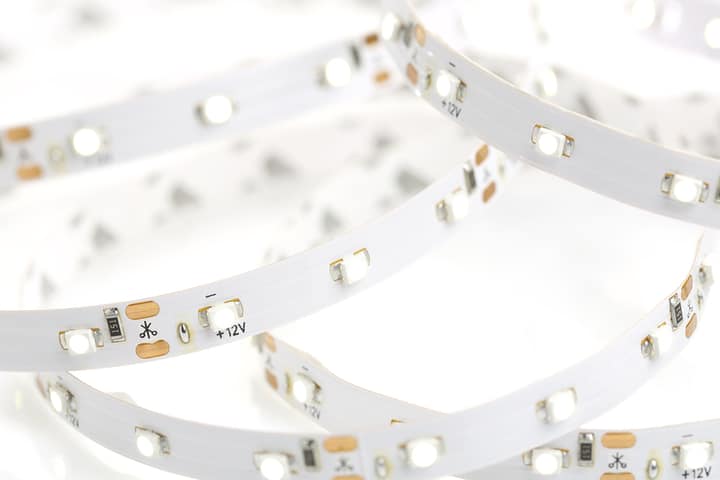
There are two main elements to working out the battery requirements for your LED strips.
- Voltage
- Strip Wattage
You must buy the right voltage to match your strip, and then you can choose battery pack with the highest mAh capacity so that it will power your strip for longer.
Voltage
LED strip lights are generally rated for either 12V or 24V. The mains power supply would normally include a mini transformer that steps the mains power down to the required voltage.
But when selecting battery packs for your strip lights, you need to match the voltage of the strip as there isn’t any transform.
So, if you’re powering a 12V strip, you’ll need 12V of battery power, and for a 24V strip, you’re going to need 24V of battery power.
If you underpower your light strip, it might work, but it probably won’t be as bright as it should be.
However, if you overpower it, providing too many volts, you’ll damage it, and it may become a hazard. So the best option is always to match the voltage.
Here’s a quick guide to typical battery sizes:
| Battery type | Voltage |
|---|---|
| Coin Cell | 3V |
| AA/AAA | 1.5V |
| Rectangle 9V Battery | 9V |
| Lithium Power Bank | 3-20V |
Coin cell batteries aren’t suitable for an LED strip light because they’re harder to chain together. They work for an LED strip remote control but not for powering the lights themselves! But the other battery types can work.
Powering A 12V LED Light Strip
You can easily buy a battery box (sometimes called a battery holder) that is designed for either AA or AAA batteries, making it simple to connect together up to 8 batteries to generate 12V.
A 9V battery could be used on its own for a 12V strip, but you won’t get the brightness you desire.
Of all the battery options for a 12V LED strip, the best is to buy a lithium battery (usually in the form of a power bank) that is rated for 12V.
Some of them can even provide variable voltage to select the right one for your circuit.
Powering A 24V LED Light Strip
Trying to wire up a 24V strip to batteries is trickier. You could buy two 12V batteries with exposed wire ends, or you could buy two battery packs designed for 8 AA or AAA batteries and wire those together in series.
But then you have the logistical problems of keeping 16 batteries charged – most rechargeable battery chargers have a capacity of up to 8 batteries at a time at most, so you’d need two of those.
Again you can rule out a coin cell, and you can rule out 9V batteries, too – wiring two together for 18V is too low, and adding a third will be dangerous.
Lithium power banks are generally closed and designed to be used with plug-in cables.
12V vs 24V: Which One Is Easier To Power With Battery Pack?
In short – if you want to power an LED strip by battery, you’ll have a much easier time if you stick to 12V strips.
One thing to note when talking about voltage – there are already battery-powered strip lights that you can buy.
You might think these could save you a lot of extra work since they’re ready-made to work with batteries.
However, most of them are powered by 3 or 4 AA batteries, providing a maximum voltage of either 4.5V or 6V.
So, you shouldn’t expect these strip lights to be really bright. However, LED strip lights are 12V for a reason – they need that power to effectively work at the proper brightness.
Cheaper strips powered by a handful of AA batteries won’t be anywhere near as good, so temper your expectations.
Wattage
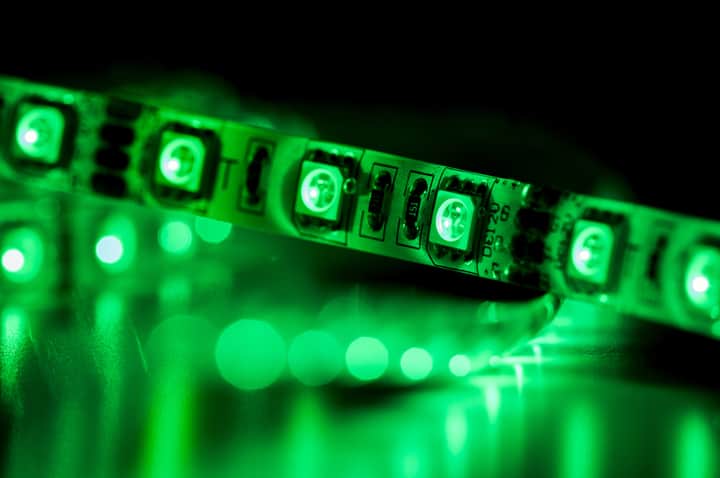
Once you’ve established the voltage of the strip you’re using, you then need to work out the wattage used by your LED strip lights. You should be able to find the watts-per-meter or watts-per-foot on the packaging or online description – multiply this by the total length of the strip to work out the total wattage.
Once you know this, you can use the formula I gave you earlier to work out how many hours a battery pack will power your LED lights. Take the milliamp hours, multiply it by the voltage of the batteries, then divide by 1,000.
Divide that by the wattage of your lights, and you’ll see how long the battery life is for your LED strip lights. You can then try to find a battery pack with a higher mAh capacity if it’s not long enough for you.
Not all LED strip lights are the same. So while it is always recommended that you connect the same strip lights together, you may connect some that tell you the total wattage and some that tell you the wattage per foot or meter.
In that case, you’ll need to do some quick math to add everything together.
If one strip tells you the wattage per foot or meter, multiply that figure by the length of that part of the strip and add it to your other strip’s total wattage.
Once you have the total wattage, you’re ready to calculate how long a battery can power it for.
Best Battery Powered LED Strip Lights
Battery-powered LED strip lights won’t be as bright as those powered by the mains, but here are some good options that may be suitable for your needs.
JUNWEN White LED Light Strip
This pack of two LED strip lights measures 13.2 feet in total (2 x 6.6 feet reels) and offers cool white and warm white settings. Powered by 3 x AA batteries (not included), it claims a battery life of up to 50 hours, but this will depend on the batteries you choose. The strip claims to offer 1,000 lumens, so around 150 lumens per foot – around a third of the brightness of a mains-powered strip light.
- Battery Operated LED Strip Lights : This 5V voltage light strip is powered by batteries, allowing...
- Portable Lighting : These lights can be placed anywhere without the need for a power outlet. Since...
Last update on 2025-10-03 / Affiliate links / Images from Amazon Product Advertising API
Govee Warm White LED Light Strip
This Govee light strip is designed for mains power but has a DC connector, so buy the right battery pack, and it will work on battery power. It offers 2,000 lumens total, which is only around 120 lumens per foot, but it’s a well-known brand so should be reliable. Battery life would depend on your chosen battery capacity.
- Warm White LED: With 300 LEDs and a 3000K color temperature, you'll enjoy an incredibly warm and...
- Dim to Desired Level: 6 levels of brightness allow you to adjust your LED strip lights for any...
Last update on 2025-10-03 / Affiliate links / Images from Amazon Product Advertising API
FAQ
Can You Convert Plug LED Strips To Be Powered By Battery?
Yes, connecting an LED strip light to a battery is possible instead of powering it with a plug. You just need to replace the plug with the battery pack – plugs aren’t usually hardwired in, so it’s simply a case of buying the right connector for your light strips to connect them to a battery power supply.
What Batteries Do LED Strip Lights Use?
LED strip lights that are already designed to use a battery pack usually use AA batteries. However, if you’re connecting your own battery pack to strip lights, you could use a power bank instead.
Final Words
Overall, it’s not exceptionally tricky to connect an LED strip to a battery pack. Still, you will need to buy a lot of extras – the battery, a charger for the battery, and all the connectors you need to wire it up.
For the time you’ll get from your battery, it’s not likely to be worth it, especially if you plan to leave your strip lights on for more than a couple of hours.
You’ll spend too much time disconnecting the battery to recharge it every couple of days.
True, your lights would stay working during power outages, but are they common enough for this to be a concern?
Ideally, sticking to mains power is more reliable and easier, so always try to find a solution before resorting to battery power.
Once you’ve chosen your LED strip lights, be sure to check out my guide on sticking LED lights on the wall so you can install them hassle-free.

